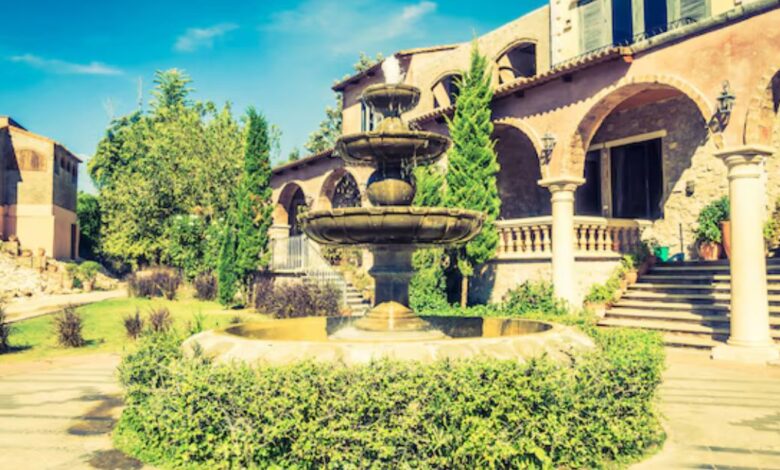Converted old noble villas in rome hotels: A Blend of History and Luxury

Rome, known as the Eternal City, is a place where ancient ruins coexist with vibrant contemporary life. Its past is as illustrious as its architecture, which speaks volumes of the city’s historical grandeur. One of the most fascinating aspects of this history is the luxurious noble villas that served as the homes for Rome’s elite. While these villas once housed aristocratic families, many have since been transformed into opulent hotels, art centers, or modern residences that retain the charm of their past. This article delves into the historical importance, architectural splendor, and contemporary adaptations of these Converted Old Noble Villas in Rome hotels, presenting a unique way to experience the city’s layered history.
Historical Significance of Converted Old Noble Villas in Rome
The tradition of noble villas in Rome began during the Renaissance and Baroque periods, when powerful families like the Medici, Borghese, and Doria Pamphili commissioned magnificent buildings to serve as their city residences or summer retreats. These families did not merely build homes; they created artistic and cultural havens where prominent artists, writers, and thinkers gathered to share ideas and showcase their work.
Villas as Cultural and Artistic Hubs
Noble families constructed villas that embodied their social status, not only in scale but in their architectural grandeur and artistic embellishments. The noble estates were celebrated for grandiose gardens, elaborate fountains, and intricate frescoes. These villas hosted art exhibitions, scholarly discussions, and opulent gatherings, and by doing so, they positioned Rome as a vital center of culture and intellectual exchange.
Preserving Rome’s Aristocratic Legacy
The legacy of these villas reflects Rome’s powerful aristocracy. Families like the Borghese and Medici were patrons of the arts and architecture, using their wealth and influence to commission artworks and buildings that conveyed their power and culture. Today, as these villas are adapted for new uses, they continue to preserve Rome’s rich past while offering unique cultural experiences to modern visitors.
Architectural Splendor: Key Features of Rome’s Noble Villas
The architectural elegance of Rome’s noble villas combines influences from Renaissance, Baroque, and Rococo styles. Each of these buildings boasts distinct characteristics that exemplify the opulence of Rome’s aristocratic heritage.
Renaissance and Baroque Inspirations
The Renaissance period emphasized symmetry, proportion, and classical beauty, elements visible in the earliest noble villas. The Baroque era, however, introduced grandeur and drama, evident in many of Rome’s converted villas. Characteristic of this style are detailed facades, expansive staircases, and lavish decorative elements such as stucco, mosaics, and frescoes, which add to the villas’ visual appeal.
Gardens and Outdoor Spaces
Landscaped gardens are integral to these properties, with lush greenery, fountains, and statues that further exemplify the grandeur of these estates. The gardens not only served as scenic retreats for the nobility but also provided a space for parties and gatherings. Some villas even had vineyards and orchards, which contributed to the self-sustaining nature of these estates.
Luxurious Interiors: Frescoes, Sculptures, and Furniture
Inside the villas, each room was a masterpiece in its own right. The walls were adorned with frescoes painted by renowned artists, and sculptures and antique furniture added a layer of elegance. Today, many converted villas retain these artistic elements, giving guests a sense of stepping back in time.
Modern Transformation: The Villas as Luxury Hotels
The modern adaptation of noble villas into luxury hotels has allowed travelers to experience the timeless beauty of these historical estates. As high-end hotels, these villas provide a unique blend of historical charm with contemporary comforts, making them a popular choice for those seeking an immersive experience in Roman culture.
Preserving Architectural Integrity
Restorations of these villas have been undertaken with great care to preserve their historical architecture. Architects and designers focus on maintaining the integrity of frescoes, facades, and other original elements, ensuring that the transformation into hotels does not detract from the villas’ history. These hotels incorporate modern amenities and technology, allowing guests to enjoy comfort without compromising historical authenticity.
Fusion of Old and New Converted old noble villas in rome hotels
Converted old noble villas in Rome hotels represent a harmonious blend of past and present. While the historic elements such as frescoes, marble floors, and ornate staircases are retained, the hotels also feature state-of-the-art spas, fitness centers, and gourmet dining options. The experience is thus a perfect union of luxurious accommodation and historical immersion.
Notable Converted Villa Hotels in Rome
- Villa Spalletti Trivelli: A beautiful estate near the Quirinal Palace, Villa Spalletti Trivelli combines heritage interiors with luxurious amenities.
- Villa Medici: Originally owned by the Medici family, this villa offers a stunning view over Rome and is now used as an art academy and hotel.
- Villa Borghese: Located near the Villa Borghese Gardens, this villa is now a renowned hotel and art gallery, showcasing its lush gardens and historical charm.
Experiencing Culture and Luxury: Activities at Converted old noble villas in rome hotels
Staying in one of these villas is more than just accommodation; it’s an experience steeped in culture and history. Many of the hotels offer exclusive activities that allow guests to explore the cultural heritage of these estates.
Art Exhibitions and Cultural Events
Some villas have been transformed into cultural centers where art exhibitions, classical music performances, and lectures on Roman history are held. Guests have the chance to view priceless works of art within these historical settings, enriching their stay with cultural immersion.
Fine Dining with a Historical Flair
Many of these villa hotels have on-site restaurants that emphasize traditional Roman cuisine with a modern twist. Dishes are often inspired by recipes from the villa’s past, using locally sourced ingredients to provide guests with an authentic taste of Roman culture.
Spa and Wellness Retreats
Taking advantage of their secluded locations, some villa hotels offer exclusive wellness programs. Spas, yoga sessions, and meditation gardens allow guests to relax in an atmosphere that harks back to the villas’ original purpose as a retreat for the elite.
Conclusion
Converted Old Noble Villas in Rome hotels provide travelers with a one-of-a-kind experience that blends luxury with historical charm. Each villa tells its own story through its architecture, artwork, and the legacy of the families that once inhabited these grand estates. Today, these villas continue to serve as cultural treasures, offering modern guests a window into Rome’s opulent past. With their carefully preserved architecture and luxurious amenities, these hotels are the ultimate destination for those who wish to indulge in the history and grandeur of the Eternal City.
FAQs
1. What is the historical significance of Converted old noble villas in rome hotels?
The Converted old noble villas in rome hotels were built during the Renaissance and Baroque periods by aristocratic families who used them as retreats and cultural hubs. These villas attracted artists, philosophers, and intellectuals, making them centers of artistic and social activity.
2. What architectural styles are prevalent in Rome’s converted villas?
These villas often reflect Renaissance and Baroque architecture, characterized by symmetry, classical proportions, grand staircases, and lush gardens. Interiors frequently include frescoes, ornate furniture, and sculptures, creating an atmosphere of opulence.
3. How have these villas been preserved during their conversion into hotels?
The conversion process focuses on maintaining the architectural and artistic integrity of the villas. Modern amenities are carefully integrated without compromising original features like frescoes, marble work, and historical facades.
4. What types of experiences do these converted villas offer?
Guests can enjoy fine dining, art exhibitions, and cultural events that reflect the villas’ history. Many hotels also provide wellness services like spa treatments and yoga, enhancing the retreat-like quality of these estates.
5. Can visitors explore the gardens of these villa hotels?
Yes, the gardens are often open to guests and are meticulously maintained to preserve their historical charm. Many gardens feature fountains, statues, and walking paths, allowing guests to experience the tranquility once enjoyed by Rome’s elite.



